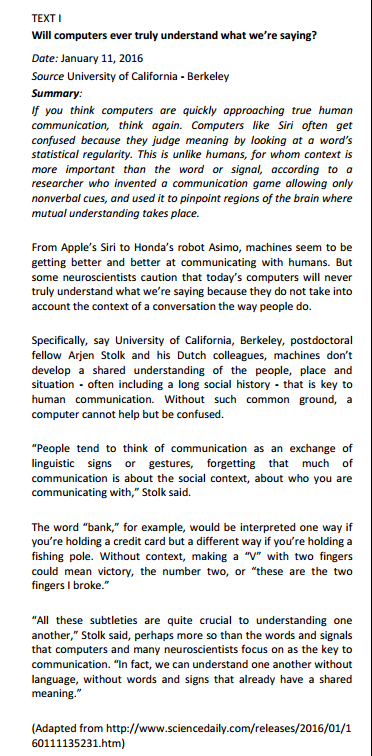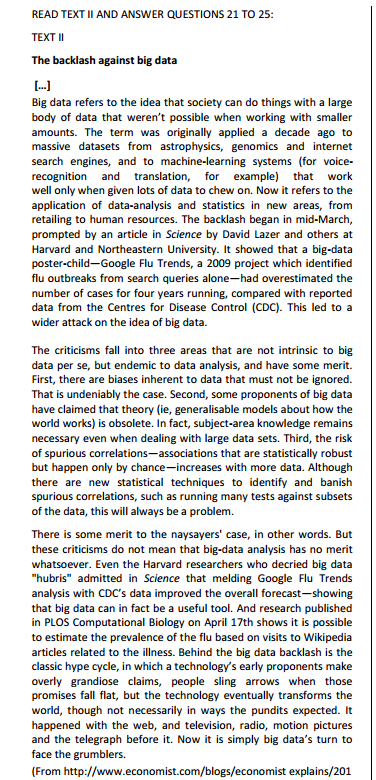Uma mensagem no protocolo SOAP, versão 1.2, é representada por um documento XML capaz de transportar dados de serviços Web. Os elementos considerados opcionais são:
Com relação ao modelo de serviços SAAS, analise as afirmativas a
seguir:
I.Devido à complexidade e ao grande número de frameworks
envolvidos, ele é considerado o modelo menos maduro na pilha
de serviços de nuvem.
II.Ele trata dos requisitos de escalabilidade, desempenho,
distribuição de dados e segurança das aplicações.
III.Está situado no topo da pilha de serviços de nuvem. Trata-se
de uma aplicação completa oferecida ao consumidor como um
serviço.
Está correto somente o que se afirma em:
When Text II mentions “grumblers” in “to face the grumblers”, it refers to:
Após a extração de uma amostra, as observações obtidas são
tabuladas, gerando a seguinte distribuição de frequências:

Considerando que E(X ) = Média de X, Mo(X ) = Moda de X e Me(X )
= Mediana de X, é correto afirmar que:
Atributos dos atos administrativos são as características que permitem afirmar que eles se submetem a um regime jurídico administrativo que os distinguem do regime jurídico de direito privado. Dentre eles, destaca-se o atributo da:
De acordo com a doutrina de direito administrativo, os serviços
públicos, quanto à maneira como concorrem para satisfazer ao
interesse geral, podem ser classificados como singulares (uti
singuli), que são aqueles que:
Francisco, servidor de fundação pública federal de direito público, percebeu vantagem econômica direta, consistente na quantia de cem mil reais em espécie, para facilitar a alienação de bem público da fundação por preço inferior ao valor de mercado, beneficiando seu cunhado, que é Deputado Federal. Descoberta a fraude, por meio de investigações levadas a cabo pelo Ministério Público Federal, o parquet ajuizou ação civil pública por ato de improbidade administrativa em face de todos os envolvidos. O processo deve tramitar perante o:
João, servidor estável de fundação pública federal, foi
aposentado por invalidez. Três meses depois, após criteriosa
análise clínica e de exames, a junta médica oficial declarou
insubsistentes os motivos de sua aposentadoria. Assim, com base
na Lei nº 8.112/90, foi determinado o retorno de João à atividade
mediante a:
Em matéria de regime disciplinar, a Lei nº 8.112/90 estabelece
que ao servidor é proibido:
Em relação à aplicação de penalidades disciplinares, a Lei nº
8.112/90 dispõe que:
A Lei nº 8.112/90 prevê que, quando se aduzirem fatos novos ou
circunstâncias suscetíveis de justificar a inocência do punido ou a
inadequação da penalidade aplicada, o processo disciplinar
poderá ser revisto. Nesse contexto, o citado diploma legal
estabelece que a revisão do processo disciplinar:
READ TEXT I AND ANSWER QUESTIONS 11 TO 15
TEXT I
Will computers ever truly understand what we're saying?
Date: January 11, 2016
Source University of California - Berkeley
Summary:
If you think computers are quickly approaching true human
communication, think again. Computers like Siri often get
confused because they judge meaning by looking at a word's
statistical regularity. This is unlike humans, for whom context is
more important than the word or signal, according to a
researcher who invented a communication game allowing only
nonverbal cues, and used it to pinpoint regions of the brain where
mutual understanding takes place.
From Apple's Siri to Honda's robot Asimo, machines seem to be
getting better and better at communicating with humans. But
some neuroscientists caution that today's computers will never
truly understand what we're saying because they do not take into
account the context of a conversation the way people do.
Specifically, say University of California, Berkeley, postdoctoral
fellow Arjen Stolk and his Dutch colleagues, machines don't
develop a shared understanding of the people, place and
situation - often including a long social history - that is key to
human communication. Without such common ground, a
computer cannot help but be confused.
"People tend to think of communication as an exchange of
linguistic signs or gestures, forgetting that much of
communication is about the social context, about who you are
communicating with," Stolk said.
The word "bank," for example, would be interpreted one way if
you're holding a credit card but a different way if you're holding a
fishing pole. Without context, making a "V" with two fingers
could mean victory, the number two, or "these are the two
fingers I broke."
"All these subtleties are quite crucial to understanding one
another," Stolk said, perhaps more so than the words and signals
that computers and many neuroscientists focus on as the key to
communication. "In fact, we can understand one another without
language, without words and signs that already have a shared
meaning."
(Adapted from http://www.sciencedaily.com/releases/2016/01/1
60111135231.htm)
Based on the summary provided for Text I, mark the statements below as TRUE (T ) or FALSE (F ). ( ) Contextual clues are still not accounted for by computers. ( ) Computers are unreliable because they focus on language patterns. ( ) A game has been invented based on the words people use. The statements are, respectively:
READ TEXT II AND ANSWER QUESTIONS 16 TO 20:
TEXT II
The backlash against big data
[…]
Big data refers to the idea that society can do things with a large
body of data that weren't possible when working with smaller
amounts. The term was originally applied a decade ago to
massive datasets from astrophysics, genomics and internet
search engines, and to machine-learning systems (for voicerecognition
and translation, for example) that work
well only when given lots of data to chew on. Now it refers to the
application of data-analysis and statistics in new areas, from
retailing to human resources. The backlash began in mid-March,
prompted by an article in Science by David Lazer and others at
Harvard and Northeastern University. It showed that a big-data
poster-child—Google Flu Trends, a 2009 project which identified
flu outbreaks from search queries alone—had overestimated the
number of cases for four years running, compared with reported
data from the Centres for Disease Control (CDC). This led to a
wider attack on the idea of big data.
The criticisms fall into three areas that are not intrinsic to big
data per se, but endemic to data analysis, and have some merit.
First, there are biases inherent to data that must not be ignored.
That is undeniably the case. Second, some proponents of big data
have claimed that theory (ie, generalisable models about how the
world works) is obsolete. In fact, subject-area knowledge remains
necessary even when dealing with large data sets. Third, the risk
of spurious correlations—associations that are statistically robust
but happen only by chance—increases with more data. Although
there are new statistical techniques to identify and banish
spurious correlations, such as running many tests against subsets
of the data, this will always be a problem.
There is some merit to the naysayers' case, in other words. But
these criticisms do not mean that big-data analysis has no merit
whatsoever. Even the Harvard researchers who decried big data
"hubris" admitted in Science that melding Google Flu Trends
analysis with CDC's data improved the overall forecast—showing
that big data can in fact be a useful tool. And research published
in PLOS Computational Biology on April 17th shows it is possible
to estimate the prevalence of the flu based on visits to Wikipedia
articles related to the illness. Behind the big data backlash is the
classic hype cycle, in which a technology's early proponents make
overly grandiose claims, people sling arrows when those
promises fall flat, but the technology eventually transforms the
world, though not necessarily in ways the pundits expected. It
happened with the web, and television, radio, motion pictures
and the telegraph before it. Now it is simply big data's turn to
face the grumblers.
(From http://www.economist.com/blogs/economist explains/201
4/04/economist-explains-10)
When Text II mentions “grumblers” in “to face the grumblers”, it refers to:
Após a extração de uma amostra, as observações obtidas são
tabuladas, gerando a seguinte distribuição de frequências:

Considerando que E(X ) = Média de X, Mo(X ) = Moda de X e Me(X )
= Mediana de X, é correto afirmar que:



